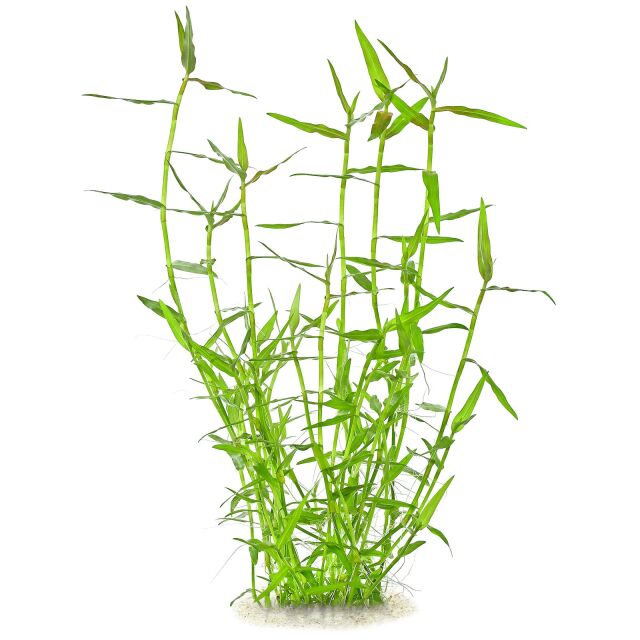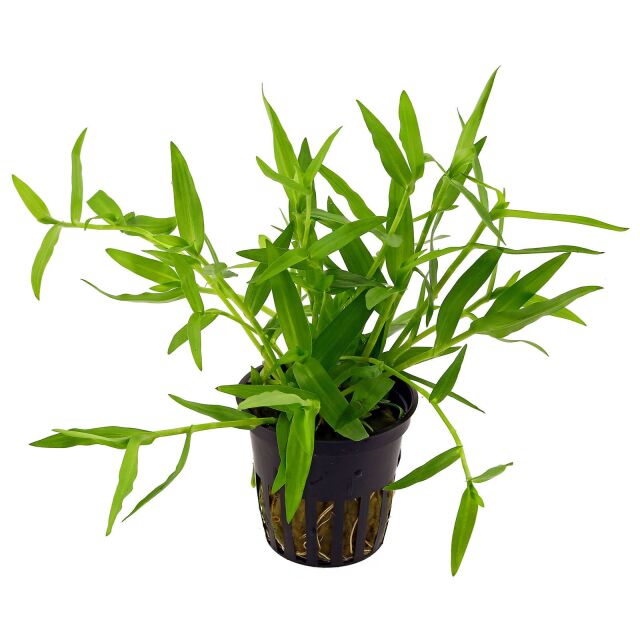Asian dayflower



Murdannia keisak
Asian dayflower
- Bamboo-like appearance
- Strictly upright growth habit
- Very light green with purple hues
- Rarely found in trade
Item question
We’re here for you!
Please enter your question and e-mail and we’ll contact you as soon as possible. It usually takes us up to 24 hours during business days to respond.
Thank you for your question!
Thank you, we’ll get in touch!
Close window
You already sent us a question.
Please wait a few minutes
Description
Murdannia keisak is a new uncommon aquarium plant. It has narrow distichous leaves, and under water it has strictly upright stems with pronounced nodes, which remind somewhat of bamboo. The leaves grow to a length of up to approx. 5 cm and 1 cm in width, the stems are around 3 mm thick. This plant belongs to the Commelinaceae family, which means it is related to plants of the genus Tradescantia, the "Golliwoog" plant (Callisia repens), Cyanotis and Floscopa. Murdannia keisak is distributed in the warmer regions of Asia, where it mostly grows as bog plant or floats in shallow water. In the aquarium it does very well when cultivated submersed. In the submersed form, the leaves are of a very light green, often with some purple hues. When nutrients are deficient, the leaves tend to assume a whitish colour. A substrate rich in nutrients and fertilisation with macronutrients is very beneficial for growth. You can let Murdannia keisak grow above the waterline, too, and it can be cultivated as bog plant in paludaria. Its emerged form has low-lying to ascending stems.
With its very narrow leaves growing in two lines Murdannia keisak looks very much like a grass, however, it truly belongs to the family of Commelinaceae, like the well-known houseplants of the genus Tradescantia or the "Golliwoog" plant (Callisia repens). Most of the 50 species in the genus Murdannia are terrestrial plants, like e.g. M. loriformis, which is used as a medicinal herb. Murdannia keisak is one of the few bog and aquatic plant species in that genus.
M. keisak is widely distributed in the warmer regions of Asia, however, it has also been introduced into the south-east of the USA, probably with rice seeds. There it spreads continuously. It has also been introduced into Italy. This plant grows in a diversity of moist places, like road ditches, river banks and lakeshores, bogs and, first and foremost, rice paddies. (read more)
| Common names | Asian dayflower, Asian spiderwort, Wartremoving herb |
| Synonyms | Aneilema coreanum H. Lév. & Vaniot, Aneilema keisak Hassk., Aneilema oliganthum Franch. & Sav., Aneilema taquetii H.Lév. |
| Misapplied names | Arthraxon hispidus |
| Complete botanical name | Murdánnia kéisak (Hassk.) Hand.-Mazz. |
| Family | Commelinaceae |
| Genus | Murdannia |
| Difficulty | medium |
| Usage | Semi-emersed plant for open tanks, Background, Midground |
| Growth | fast |
| pH value | 5 - 7 |
| Temperature tolerance | 18 - 30°C |
| Carbonate hardness | 0 - 14°dKH |
| General hardness | 0 - 30°dGH |
| Propagation | Seeds, Cuttings |
| Can grow emersed? | yes |
| Source | Flowgrow |
| Common names |
| Asian dayflower, Asian spiderwort, Wartremoving herb |
| Synonyms |
| Aneilema coreanum H. Lév. & Vaniot, Aneilema keisak Hassk., Aneilema oliganthum Franch. & Sav., Aneilema taquetii H.Lév. |
| Misapplied names |
| Arthraxon hispidus |
| Complete botanical name |
| Murdánnia kéisak (Hassk.) Hand.-Mazz. |
| Family |
| Commelinaceae |
| Genus |
| Murdannia |
| Difficulty |
| medium |
| Usage |
| Semi-emersed plant for open tanks, Background, Midground |
| Growth |
| fast |
| pH value |
| 5 - 7 |
| Temperature tolerance |
| 18 - 30°C |
| Carbonate hardness |
| 0 - 14°dKH |
| General hardness |
| 0 - 30°dGH |
| Propagation |
| Seeds, Cuttings |
| Can grow emersed? |
| yes |
| Source |
| Flowgrow |
General information
| Item no. |
|
| EAN | 5703249135001 |
| Weight | 0,10 kg |
| Shipping weight | 0,10 kg |
Customers ask customers
You have questions about this product? Ask other customer or our support team about this product!
Customer reviews
11 Reviews
| 5 Stars(9) |
|
| 4 Stars(0) |
|
| 3 Stars(2) |
|
| 2 Stars(0) |
|
| 1 Star(0) |
|

Arrived in a perfect condition and both plants were a lot taller and bushier than pictured (what a nice surprise! (read more)